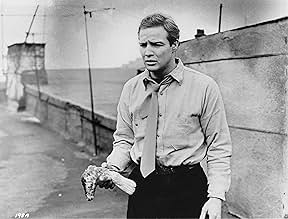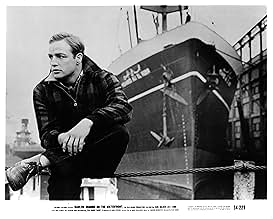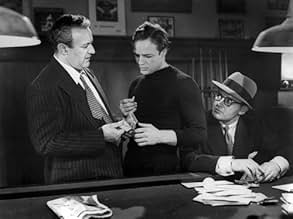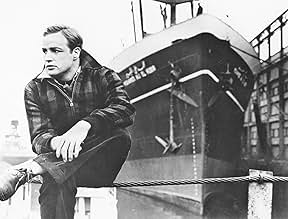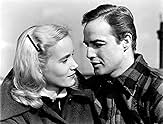Un exluchador, convertido en estibador de Nueva Jersey, lucha por enfrentarse a sus corruptos jefes sindicales, incluido su hermano mayor, mientras empieza a conectar con la afligida hermana... Leer todoUn exluchador, convertido en estibador de Nueva Jersey, lucha por enfrentarse a sus corruptos jefes sindicales, incluido su hermano mayor, mientras empieza a conectar con la afligida hermana de una de las víctimas del sindicato.Un exluchador, convertido en estibador de Nueva Jersey, lucha por enfrentarse a sus corruptos jefes sindicales, incluido su hermano mayor, mientras empieza a conectar con la afligida hermana de una de las víctimas del sindicato.
- Dirección
- Guión
- Reparto principal
- Ganó 8 premios Óscar
- 30 premios y 11 nominaciones en total
- 'Pop' Doyle
- (as John Hamilton)
- Gillette
- (sin acreditar)
- Sidney
- (sin acreditar)
Resumen
Reseñas destacadas
In the most famous scene, Brando, a has-been prizefighter, confronts his brother (Steiger) who is about to set him up to be executed by the mob bosses of the union. When Steiger reveals his intent to set Brando up, the scene explodes with reality and pathos. Brando's words, "Wow", sum up the intensity and emotion of the scene.
Great acting and directing, however, cannot cover up the transparent political/apologetical intent of the movie. Two years earlier, Kazan had sold out his integrity to the House Unamerican Affairs Committee (HUAC), "naming names" of those who would become the blacklisted Hollywood 10. Kazan, a former communist himself, regretted his involvement with the Party, and evidently decided it was politically advantageous to name his former associates. Likewise, Brando character Malloy finds himself in a mob-run labor union, and in his effort to 'get out', repeats much of what Kazan did in real life. Worse, Kazan, through the allegorical message of the film, brands his former writers as criminals and murders, and himself as the naive innocent. Being a communist was no crime in the 30s, and he was no innocent.
"On the Waterfront" is thus steeped in a right-wing political worldview. Mobs run labor unions. Unions are thus corrupt organizations who exploit workers and make it harder for businesses to thrive. Turn in union leaders into the police. Even the church becomes a tool of the state to further the cause of the police against the union.
Brando was never satisfied with "On the Waterfront". In fact, he later commented that it was indeed a tool for Kazan to justify his actions to the HUAC. One thumb up for the acting, one thumb down for the cheap political message.
Unquestionably, the strength of the film is the acting. Brando's performance in particular is one for the ages. He won his first Oscar for this role and Eva Marie Saint also garnered an Oscar in her introductory film role. On top of that Karl Malden, Lee J. Cobb & Rod Steiger all earned Best Supporting Actor nominations. These accolades give an idea of the level of talent on display here.
Kazan's direction is well done as he strives for a gritty, realistic look. Shooting on location was an important part of that. Leonard Bernstein's score, on the other hand, is often overbearing. There's nothing wrong with the music itself, only the prominence of it.
The main area in which I feel the film doesn't quite deliver is the story. The film does a fine job of exploring the characters but I find that the underlying storyline doesn't really work for me. The main premise is a good one but after the initial confrontation I began to lose interest. The self-consciously 'inspiring' ending doesn't help, either.
All things considered, I give the film high marks for the excellent acting and direction which, unfortunately, are in service of a merely average story.
I haven't long completed Target, The Corruptors, and the wonderful algorithms suggested this film, what a great suggestion. Very much a story of people suffering at the hands of The Mob, and someone forced to bracelet make a stand.
This film is very gritty, very well paced, and boy you get a sense of the poverty and desperation of those men.
Marlon Brando makes this film so incredibly watchable, his performance is nothing short of captivating, he exudes masculinity, anger, rage, conflict and love. He definitely appears haunted in this movie, he has a look in his eyes.
9/10.
The curtain opens with Terry working for Johnny Friendly to be participated in a murder. He does his duty and the murder takes effect. The victim was a labor, whose labor leader also works for Johhny Friendly. Terry turns gloomy when he finds out that the victim has been only seeking his rights when he became a rebel. Especially when Terry meets with the victim's sister his suspects grew. She reasons with him that there are two opposite sides: Johnny Friendly's rich and still-growing syndicate versus the dependent and needy workers who are driven into Johnny Friendly's punitive sanctions. Provided that Terry finds a third side: His own.
A run of the mill plot of the mid-20th century. Everybody is pretty much familiar with labor union issues. Mainly the subject gives nothing more than workers seeking out their rights. However, consider that it's Elia Kazan who ushers a new era of actors who rage the whole scenes and turn out heroes out of bums. On the Waterfront has surely inspired millions. For instance, in Robert De Niro's "Raging Bull", a prize-fighter like Terry Malloy turns out to be a stage actor and affirms Terry's speech of reproach to his brother, where no other words could describe his situation he fell into.
Marlon Brando's can-do attitude created an inspirational movement, imprinting our memory, that "If Terry Malloy can do this, yes; I can do this, and yes; everybody can do this". Subsequently movie makers began to deliver efforts and accomplishments to the silver screen in order to catch viewers' appreciations. On The Waterfront, Elia Kazan and Marlon Brando are those to remember together in the motion picture history.
I finished On the Waterfront about 2 hours ago, and something strange happened. Something I haven't done in a long while, I can't for certain remember the film that caused it. When the film ended, I sat in silence for about 10 minutes.
On the Waterfront is an inspiring film. There's a feeling you get watching it- movie magic. Something great is playing out in front of your eyes and you are taking in the collective effort of geniuses. Right from the start, with the dramatic score (that stays fine throughout) introducing the film, something special is happening.
The plot synopsis gives the appearance of a plain film, and plain it is not. The mob, murder and romance are the stars of this show and right off the start this is apparent- like the lighting of a fuse. Then as the wick burns down, the drama unfolds. We learn about Terry Malloy (Marlon Brando), his past and present, and his conflicted thoughts. We are introduced to characters that push him down the path he has to choose. A viewer grows to care about Terry, and until he decides for himself, we have no idea what he'll do.
This film is an acting gold magnet- it received 5 nominations in acting alone. I'll start with Brando's legendary performance. It doesn't matter what you think of him offscreen because for 2 hours he is at his very best, one of the best in acting ever. Terry is a fantastic character and Brando gives an unrivalled, honest performance.
Wanting him to stand against his negative influences are Father Barry (Karl Malden) and Edie (Eva Marie Saint). The father is a frustrated man, furious in his quest for righteousness. Only in The Exorcist have I liked a priest as much. He gives a raging performance, at its peak with a scolding of the longshoremen. Riveting. With him, but quite the opposite in character is Edie, who falls into the plot. Saint aces her characters role, which is to mold Terry. Their scenes are tender, believable, and in a recurring theme with the film, honest. During their bar scene I thought they could've just made a romance together, leaving out all the drama.
On the other side, the mob union leaders, we have Johnny Friendly (Lee J. Cobb), the head honcho, who is ferocious, intimidating, and impeccably evil to honest workers. There's also Charley (Rod Steiger), Terry's older brother who is comfortably in with the mob. I didn't notice him at all, except for 'the scene' which must've made him in the Academy's eyes.
Speaking of 'the scene', the pivotal Taxi cab dialogue between Terry and Charley, you can tell as it happens this is the moment, the peak of On the Waterfront and Marlon Brando. It is the turning point of the film, where Terry makes some huge realizations that we can infer from only his face and tone. I won't even discuss his words, as it's been done by absolutely everyone. There are several other great scenes, like the 'It's a crucifixion' speech and the various rooftop scenes.
Right until the last scene we aren't sure what will happen. I won't spoil it, but it's elevating. Heroic. Even enlightening.
On the Waterfront is about the small speaking out against the large and corrupt. It's about going against the flow, breaking the silence. Sometime in your life you were or will be in Terry's position to some degree, and you'll either do or don't. Leave it at that, please don't read the director's reasoning behind the film. Take it for what it is: a fantastic film that will make you want to be a better person who can speak out against wrongdoers. Powerful indeed.
I thought On the Waterfront would be good, but not this good. With stupendous performances, a top notch story and a strong message, On the Waterfront is film at it's best. 9.4/10
Oscars Best Picture Winners, Ranked
Oscars Best Picture Winners, Ranked
¿Sabías que...?
- CuriosidadesIn his biography of Elia Kazan, Richard Schickel describes how Kazan used a ploy to entice Marlon Brando to do the movie. He had Karl Malden direct a scene from the film with an up-and-coming fellow actor from the Actors Studio playing the Terry Malloy lead role. They figured the competitive Brando would not be eager to see such a major role handed to some new screen heartthrob. The ploy worked, especially since the competition had come in the form of a guy named Paul Newman.
- PifiasWhen Father Barry (Karl Malden) gets hit in the head with a beer can, he gets a cut on his forehead, which bleeds visibly in the scene. In subsequent scenes, there is no sign of the cut or of a bandage to show that he had been hurt.
- Citas
Charley Malloy: Look, kid, I... how much you weigh, son? When you weighed 168 pounds you were beautiful. You coulda been another Billy Conn, and that skunk we got you for a manager, he brought you along too fast.
Terry Malloy: It wasn't him, Charley, it was you. Remember that night in the Garden you came down to my dressing room and you said, "Kid, this ain't your night. We're going for the price on Wilson." You remember that? "This ain't your night"! My night! I coulda taken Wilson apart! So what happens? He gets the title shot outdoors on the ballpark and what do I get? A one-way ticket to Palookaville! You was my brother, Charley, you shoulda looked out for me a little bit. You shoulda taken care of me just a little bit so I wouldn't have to take them dives for the short-end money.
Charley Malloy: Oh, I had some bets down for you. You saw some money.
Terry Malloy: You don't understand. I coulda had class. I coulda been a contender. I coulda been somebody, instead of a bum, which is what I am, let's face it. It was you, Charley.
- Créditos adicionalesOpening credits are shown over a bamboo-type mat background.
- Versiones alternativasCriterion Collection Blu-ray Disc release exhibits the film in 1.66:1, which is widely regarded to be the "correct" aspect ratio for the film. However, a second disc includes the film in 1.33:1 AND 1.85:1, so that viewers can watch the film in the different ratios.
- ConexionesEdited into Un Américain nommé Kazan (2018)
Selecciones populares
Detalles
- Fecha de lanzamiento
- País de origen
- Idiomas
- Títulos en diferentes países
- La llei del silenci
- Localizaciones del rodaje
- Empresa productora
- Ver más compañías en los créditos en IMDbPro
Taquilla
- Presupuesto
- 910.000 US$ (estimación)
- Recaudación en todo el mundo
- 3768 US$
- Duración1 hora 48 minutos
- Color


